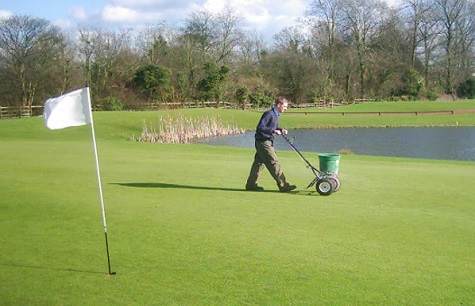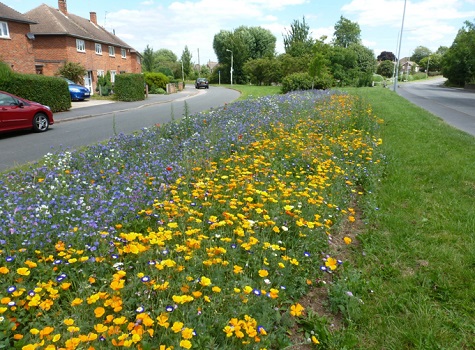After all the recent poor weather, hopefully the month of March will bring some much needed respite with a dose of sunshine and drying winds that will no doubt help improve the condition of our playing pitches along with some spring colour in our parks and open spaces.
March is known for plenty of colour with winter flowering cherries starting off the parade, soon followed by displays of crocus, daffodils and spring flowering shrubs such as white flowering viburnums and jasmine.

Soil and air temperatures soon start rising into double figures, initiating the first flush of grass growth which will no doubt get many people getting their mowers out of winter storage. Those with robotic mowers, it also signals the time for them to get them set and primed to go.
On the domestic front, the sales of both robotic and battery powered mowers will continue to grow. Most dealers I have spoken to are gearing up and forecasting a higher turnover on these products. I myself am considering buying a new battery powered mower for my gardening round.
On the sporting front, the preparation of cricket pitches begins in earnest in March with the preparation of the square and outfields.

For most cricket facilities the recent wet weather will have prevented any work being carried out. However, as soon as you can, once the ground has dried out sufficiently you should get on with the first cut of the year - cutting both the square and outfield followed by a pre-season rolling programme to consolidate the square.
Pre-season rolling is absolutely crucial to the production of decent fast pitches, as the cricket square requires a firm, even surface and rolling should commence as soon as conditions permit. The groundsman is the only person who can decide when conditions are suitable.
The use of rollers to firm the surface over a period of several weeks will slowly consolidate the square. Use a light roller at the earliest opportunity in the spring, possibly at the end of February or the beginning of March, gradually increasing the weight, if possible, up to a 2028kg (2 ton) heavy roller.

The pitch should be rolled in all directions, with the emphasis on cross rolling in the early stages but finish on the line of play of the pitches. The aim is to consolidate the square to a depth of 100mm (4 inches) before the commencement of the season. Light scarification may be necessary in the early spring, but this should only be done in moderation with great care being taken not to destroy grasses sown in the previous autumn.
In terms of mowing, gradually reduce the height of cut on the square approaching the start the season to a height of 12mm (1/2 inch). This height should be maintained all season over the square, with it being cut at least once a week if not twice during growing conditions.
One of the best detailed guides to the preparation of cricket facilities can be found via the ECB. The TS4 document on the preparation and maintenance of cricket pitches is well worth a read.

As we move to the end of the month many winter sports pitches will themselves becoming to the end of their playing season and will require some rest and recuperation. Universally known as an end of season renovation. Again, something I have mentioned in previous blogs.
It is important we find the resources and money to undertake this work. Cleaning out dead material, aerating, re populating the sward with new seed, top dressing and fertilising helps restore and rejuvenate natural grass playing surfaces.

With regard to fine turf playing surfaces such as bowls, golf and tennis, these facilities will need some spring renovations to revitilse them and set them up for the summer’s play.
Priority work for March is to aerate the playing surfaces to help gaseous exchanges and increase water infiltration through the soil profile. An application of iron sulphate will help improve colour and kill any moss that has established during the winter months. Some clubs apply a lawn sand to kill the moss.
You will need to ensure your mowers are ready for the start of the season, serviced and sharpened and ready to go. Check your height of cut, you do not want to be cutting too low. Some clubs may even use pedestrian rotaries to help clean up the green and carry out their initial cuts.

You should have planned and ordered your spring renovation materials by now. Your renovations will be based around a good aeration of the playing surface, some light verticutting / scarification to remove some side and lateral growth, coupled with a light dressing of topdressing, usually a 80/20 sand soil rootzone material, to restore levels and to provide a seed bed for some new seed which you will sow into the green.
One of the biggest turf problems we will see this year after such a poor winter is the ingress of moss. Coming out of this unseasonal wet and mild winter weather, there will be many clubs suffering from a build-up of moss and algae problems.

Mosses are primitive, non-flowering plants that have no root structure and rely on there being sufficient moisture in the environment for reproduction and survival. The majority of mosses are tolerant of acidic conditions and are stimulated by wet, humid conditions. Rapid colonisation of moss and algaes usually occur during autumn and winter months when turf surfaces are lying wet and saturated for long periods of time, particularly when little or no aeration has been undertaken.
Remember, moss is the symptom of poor grass growth and not the cause of it. If you make sure you have a tightly knit sward next year, and have maximised drainage with plenty of regular aeration, you should not have to deal with moss at all.
If you are saddled with a turf situation that has a lot of moss present, there will be a requirement to kill off the moss. The only product now available to control moss in turf is sulphate of iron (Ferrous Sulphate), which is relatively cheap and effective. It can be applied in two ways - liquid or granular (lawn sand). Apply at recommended rates.

It will take between 7-14 days for the moss to die and turn black. Once it has, it is then time to remove the moss by scarification/ raking. Re-treatment may be necessary for heavy infestations.
Lawn sand might also be worth a try. When using lawn sand, it is important you use a compatible sand product that matches your rootzone soil profile. You do not want to create a layering problem.
Any bare or sparse areas can be lightly tilthed, overseeded and topdressed with a sand/soil rootzone mix. It will then take anything between 7-14 days for the new seed to germinate depending on the soil and air temperatures.

Finally, I just want to mention the difficult demands now made on many councils to save money and reduce costs in the maintenance of public open spaces. As a current Green Flag Awards Judge there is a lot of work being done within local government to retain these valuable open spaces and reduce costs of their ongoing maintenance. In recent years we have seen an upsurge in the provision of wildflower / flora displays which have been very well received by the public and are a brilliant way to improve the biodiversity of the site and attract a lot of insects. An interesting article on this subject which we published by Bernard Sheridan can be read here.
Wildflower seed merchants supply mixtures of wildflowers and grasses suitable for various soil types and situations. Choose one that suits your local conditions. Where possible, obtain seed of British origin. It is advisable not to take plants from the countryside and repeated seed collection would be likely to have a destructive effect on many species over time. In some cases, it also can be illegal.

Sow during March and April or in September, depending on soil conditions. On lighter soils, autumn-sown seeds generally germinate and establish quickly, although some will not come up until the following spring. This delay makes it advisable to wait until March or April on heavy soils, as waterlogging may cause the seed and seedlings to rot during winter.
Further information can found on the excellent RHS website.
I personally look forward to March and April - two of the most rewarding months in terms of seeing our landscape change and burst back into life.